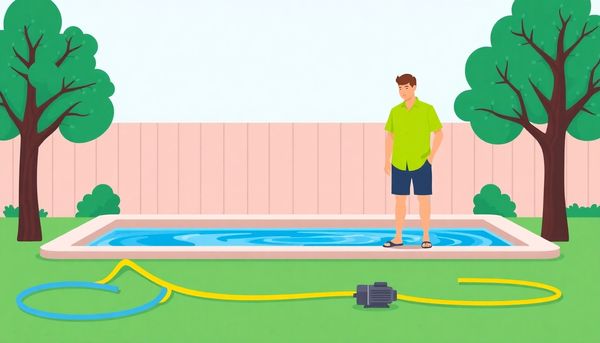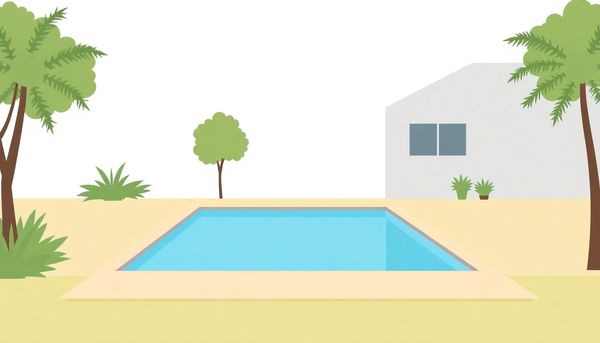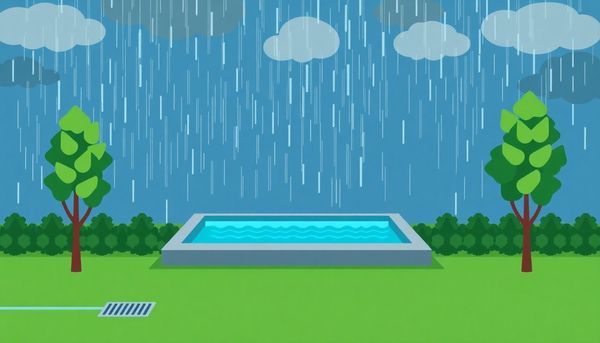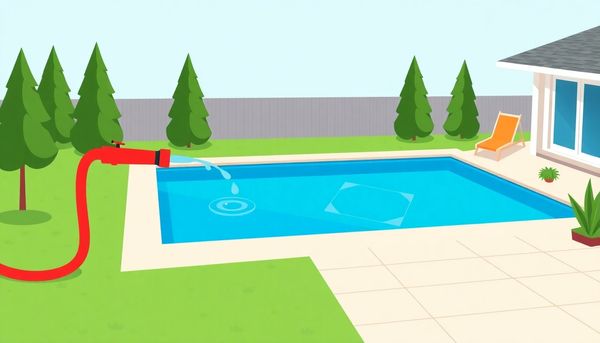Master Inground Pool Draining: Essential Tips for Safe Maintenance
June 09th, 2024
June 09th, 2024
Draining an inground pool is more than just pulling the plug; it's an intricate task that requires careful planning and execution. As a child, some of my fondest summertime memories involved the cool embrace of our backyard pool. However, once I took on the responsibility of maintaining it, I discovered how crucial it is to understand the intricacies of pool care, especially when it comes to draining it properly.
The process begins with a comprehensive understanding of the pool's specific needs. Whether you're addressing maintenance issues, such as repairing leaks or preparing for winter, each scenario demands a tailored approach. Ignoring these considerations might lead to unforeseen complications like structural damage or even legal penalties due to improper drainage.
Selecting the right equipment is critical. A submersible pump, often a hero in this narrative, plays a pivotal role. It efficiently removes water without causing harm to the pool’s structure. Still, one must be mindful of local regulations regarding water disposal. Just as I learned when my neighbor kindly reminded me of our town's guidelines, overlooking these rules can lead to unnecessary fines.
Moreover, the timing of the operation is essential. Draining during the wrong season or weather conditions can wreak havoc on your pool's foundation. Having a well-thought-out plan ensures the task is completed safely and effectively, preserving your pool for many more summers of enjoyment.

Imagine spending a bright Saturday afternoon by your backyard oasis, only to face the nightmare of a "popped" pool. The ground underneath an empty pool can exert pressure sufficient to lift it out of place—a costly and disheartening event. Understanding the dynamics of pool-popping is crucial for any pool owner planning a drainage project.
First, consider the state of your surrounding environment. If recent storms have saturated the ground, patience becomes your best friend. Allow the soil ample time to dry before proceeding. Even after a sunny spell, the earth might still carry hidden moisture, eager to push against an empty pool. Planning your drainage during an extended dry period reduces this risk.
Next, think about where to direct the water. Rather than letting water saturate the soil around the pool, aim for a sewer cleanout. This prevents the double whammy of removing water from your pool only to have it linger nearby, compounding the pressure problem. Just be sure the sewer path is clear; a sudden blockage could derail your best-laid plans.
Lastly, embrace the role of hydrostatic pressure relief valves. These under-the-radar heroes allow groundwater to enter the pool, easing the pressure before it becomes a destructive force. Keep these valves in top condition and ready for action when the pool level drops significantly. By following these measures, you protect not just your pool but also your peace of mind.
In the world of backyard sanctuaries, ensuring your inground pool doesn’t suddenly become a boat floating on land requires some savvy drainage techniques. A crucial first step involves checking local regulations. Some municipalities have specific rules on where you can direct pool water. Ignoring these could lead to hefty fines, so take a moment to understand your local guidelines.
When it's time to drain, using a submersible pump is a common choice. Setting up the pump at the pool's lowest point helps efficiently remove water. However, the water’s destination is equally important. Directing the outflow to an appropriate sewer cleanout, rather than letting it flood the backyard, minimizes the risk of pool popping by preventing ground saturation.
It’s also wise to keep an eye on the weather. Dry conditions are your ally, as they reduce the chance of groundwater pushing against the pool. If you’ve just had a downpour, give the earth time to recover. A friend of mine learned this the hard way; his pool shifted slightly after a rain-soaked drainage attempt, leading to costly repairs.
Don’t overlook the benefits of hydrostatic pressure relief valves. They offer an escape for groundwater, reducing pressure beneath the pool. Opening them only once the pool is mostly drained can avert a mini-disaster. In short, thoughtful planning and adherence to these techniques can save you from a floating fiasco.
Safely managing hydrostatic pressure is an essential step when draining an inground pool. This isn't just a matter of easing the water out; it's about understanding the forces at play beneath your pool. In areas with high water tables, groundwater can exert enough pressure to push an empty pool upward, potentially causing significant damage. It's like trying to keep a beach ball submerged—it takes weight and careful handling.
Before you start draining, check the weather forecast. A dry spell is your best friend here. If the ground is saturated from recent rain, take a pause. The earth needs time to dry out to reduce the risk of hydrostatic pressure. While it may seem clear on the surface, moisture can lurk several feet below, waiting to surprise you.
Hydrostatic relief valves play a crucial role in this process. These valves, often located at the deepest part of your pool, provide a pathway for groundwater to escape into the pool, rather than pushing from below. Once most of the water is out, carefully open these valves. You might see water gushing up, which is a reassuring sign that pressure is being relieved. However, be prepared with replacement valve plugs, as the removal process can sometimes damage them.
Act swiftly with any necessary repairs or maintenance to minimize exposure time. Once ready, seal the valves securely, refill the pool promptly, and ensure everything is in place to maintain your pool’s integrity. With a touch of patience and precision, you'll keep your pool safe and sound.
When the skies have been clear for weeks and the earth has had ample time to dry, it's a prime opportunity to think about draining your inground pool. Choosing dry weather is crucial because saturated ground can lead to costly complications, like the dreaded pool pop. When water is no longer pressing from the inside, the pressure outside can push your pool upwards, especially when the ground is waterlogged.
While planning the drainage, consider the logistics carefully. Instead of letting thousands of gallons spill onto the ground, find a sewer cleanout or direct the water downhill away from the pool. This not only prevents increasing pressure on the pool walls but also avoids flooding your yard. If it's been some time since you last checked the main drain, use a treatment to ensure it's clear and functional. A backup might mean you're back to square one with water pooling where you don't want it.
Once you're ready, the flow of water needs careful coordination. A drainage hose that efficiently routes water to the right location will save you headaches. If you notice any issues, such as unexpected pooling, adjust immediately to avoid soil saturation around the pool's structure. By planning during a dry spell, you’re setting yourself up for success, ensuring that your pool remains grounded while performing necessary maintenance or improvements.

Encountering hydrostatic relief valves for the first time might sound intimidating, but these small components are crucial in preventing your inground pool from becoming a costly eyesore. Picture your pool's floor as a strategically engineered landscape. Among its features are a few seemingly inconspicuous white rings, often overlooked unless you know their purpose. These rings cover vital valves that serve as a safeguard against the notorious pool pop.
Embedded into the floor, each valve is connected to a slotted pipe, which then leads to a gravel pit beneath the pool. When you drain your pool, these valves provide an escape route for groundwater that would otherwise build up pressure, potentially lifting your pool like a disgruntled guest at a garden party.
Opening these valves requires a cautious approach. Wait until the pool is nearly drained to avoid unnecessary pressure shifts. Start with the valve at the center of the deep end. In regions with a high water table, consider opening an additional valve to further mitigate risks. As you unscrew the valve, water might gush into the pool, a reassuring sign indicating the release of pent-up pressure below.
Once your work is complete and it's time to refill the pool, ensure the valves are securely closed. This may involve replacing worn plugs and sealing them with Teflon tape to prevent leaks. With the valves back in place and your pool refilled, you can relax knowing you've taken the necessary steps to protect your investment against unwanted upheaval.
Navigating the world of pool maintenance can sometimes feel like mastering a secret art, with its own set of rules and precautions. One of the most critical aspects is understanding the balance of pressure and water, especially when draining your inground pool. Ignoring these factors can result in the notorious "pool pop", where the pool literally lifts out of the ground. A dramatic scenario, but one that can be avoided with careful planning.
In regions with a high water table, the risk of pool popping increases when the water is fully drained. The pool's water weight counterbalances external pressure from groundwater. When this balance is disrupted, the pool shell might float. To prevent this, consider partial draining when feasible, reducing the risk while achieving the maintenance you need. If complete drainage is unavoidable, like during major repairs, it's prudent to consult with a professional. They can ensure that any hidden threats are addressed before they become costly disasters.
Timing is another critical factor. Draining should not coincide with rainy seasons when the ground is saturated. Dry spells offer the best chance for a safe drain. Moreover, directing drained water away from the pool area helps maintain soil stability surrounding your pool. Utilize hydrostatic relief valves to manage underground water pressure. Opening one or two valves will allow groundwater to escape safely, protecting your pool's integrity.
These thoughtful precautions can help you keep your pool in its rightful place—ready for summer fun and relaxation.
Successfully managing water drainage when draining an inground pool is akin to handling a delicate balancing act. It's crucial to be vigilant about where the water ends up, to prevent any potential disaster. One might think that just letting the water flow freely across the backyard is harmless, but it's not that simple. The ground can become oversaturated, mimicking the effect of heavy rain, and increase the risk of your pool popping due to water pressure buildup from below.
For proper drainage, consider directing the water to a sewer cleanout if local regulations permit. This method ensures the water is channelled away from the vicinity of the pool, minimizing the threat of groundwater pressure. However, be aware of potential clogs in the sewer line that might halt the drainage process. To prevent any surprises, it might be wise to clear your main drain line beforehand using a suitable drain treatment.
Additionally, if you have the option, position the drainage hose so it slopes downhill from the pool. This precaution helps to guide the water away efficiently, should unexpected blockages occur. By taking these steps, you not only safeguard your pool but also protect your property from potential water damage.
Sharing from personal experience, planning ahead and consulting with local experts can turn a potentially daunting task into a smooth process. It’s about ensuring that each drop of water has a safe destination, maintaining the integrity of your pool and peace of mind.
Handling the valves during pool drainage demands a careful approach, much like navigating a ship through stormy waters. These valves, especially the hydrostatic pressure relief valves, are your secret ally against the dreaded pool pop. When the pool is almost drained, it’s time to address these valves. Never rush this step; doing so could lead to costly mistakes.
Begin by identifying the valve in the center of the deep end—this one often serves best in releasing built-up pressure. With a steady hand, remove the valve cap. Encountering a mini-geyser of water is not just possible but expected. This phenomenon indicates that you've successfully provided an outlet for the groundwater's pent-up pressure, effectively safeguarding your pool from the perilous pop.
If you reside in an area with a high water table, consider opening a second valve to further alleviate any lurking pressure. However, do not attempt to open these until the pool is mostly drained to prevent unnecessary complications.
Once your tasks are complete, it's crucial to seal the valves securely. Damaged valve plugs are common, so having replacements at the ready can save time. Apply teflon tape on the threads of a new plug for a snug fit, and twist it back into place. This attention to detail ensures that when your pool is refilled, it remains leak-free and ready for the season ahead.

In the world of pool ownership, ensuring proper drainage direction is paramount when the time comes to drain an inground pool. Unlike simply pulling a plug like in a bathtub, the process demands thoughtful planning to avoid complications. Each drop has a destination, and directing it correctly can prevent a myriad of potential issues.
Start by understanding your landscape. If your property slopes, use gravity to your advantage by directing the drainage downhill, away from your pool. This reduces the risk of water accumulating around the pool's foundation, which can lead to hydrostatic pressure build-up—a notorious culprit behind pool popping. For those with flatter terrain, creativity with hose placement will be necessary to ensure water doesn't pool where it shouldn’t.
Consider local regulations and environmental factors as well. In some regions, draining pool water into the sewer system is not just beneficial but legally required to prevent environmental harm. However, if you encounter a clogged sewer, the water needs an alternative route. A simple trick is to use a drainage hose long enough to reach a nearby storm drain or a designated drainage area, ensuring the water is carried far from the pool's foundation.
Remember, meticulous planning in directing the drainage not only safeguards your wallet from costly repairs but also maintains the surrounding environment. The task of draining an inground pool, when approached with foresight and care, becomes less of a daunting chore and more of a manageable project that protects your investment.
The idea of your pool suddenly transforming into an uninvited guest above ground might sound like a scene from a disaster movie, but it's a very real risk when draining an inground pool. In areas where the groundwater eagerly awaits to fill any vacant space, even a slight oversight in draining can lead to a pool pop. This phenomenon occurs because the immense weight of water, which usually holds the pool in place, is removed, allowing external water pressure to take over and push the pool upwards.
Understanding your local environment plays a crucial role. For instance, if you’ve experienced days of relentless rainfall, patience becomes your best ally. Allow the earth ample time to shed its excess moisture before taking any action. A seemingly dry lawn can deceive you; hidden beneath the surface, soggy soil may still be plotting a pool pop.
Moreover, the direction in which you drain matters just as much as when you drain. Channeling pool water towards a sewer cleanout, rather than letting it saturate the ground around the pool, can make all the difference. Imagine redirecting all that potential mischief downhill, away from your beloved pool. In instances where the drain lacks regular maintenance, consider preemptively clearing it to avoid unexpected backups.
Equipping yourself with this knowledge not only safeguards your investment but also saves you from the heartache of watching your pool's unintended ascent.
In the world of pool maintenance, directing water safely during drainage is as crucial as the process itself. Consider this: where will all that water go? It’s not just about removing water from the pool, but ensuring it’s rerouted in a way that doesn’t sabotage your surroundings or invite costly repairs.
Think of your drainage plan as a roadmap. Begin by identifying your pool's nearest sewer cleanout, the ideal destination for your water's voyage. If your pool's geography allows, set your sights on the downhill path, using gravity to your advantage. This strategic direction ensures that in the event of any sewer blockage, water won’t linger around your pool—an oversight that could potentially transform your lawn into an unwanted swamp.
Personal experiences can underscore the importance of preparation. A friend once overlooked the need to check his sewer line before draining. The result? A backup that left his yard soggy for days, a mess easily avoided with a little pre-drain maintenance. Before opening the floodgates, a simple drain treatment can clear accumulated debris like grease and paper, smoothing the water's exit.
Remember, directing thousands of gallons requires precision. Lay your drainage hose carefully, and check connections to prevent any unexpected, and possibly disastrous, detours. By planning ahead and monitoring the process closely, you can safely direct water away from your pool, preserving both your pool’s structure and your landscape.
Understanding hydrostatic pressure is crucial when draining an inground pool. This unseen force can transform your backyard oasis into a troublesome eyesore if not managed properly. Hydrostatic pressure refers to the pressure exerted by the groundwater against the walls and floor of your pool. When a pool is full, the water inside counters this pressure. However, draining your pool removes that counterbalance, allowing groundwater pressure to push the pool structure upwards—an occurrence known as "pool pop," which can be both surprising and damaging.
You might wonder how to mitigate this risk. Hydrostatic relief valves, embedded during pool construction, play a vital role here. These valves allow groundwater to flow into the pool as it’s being drained, relieving pressure from beneath. Opening these valves at the right time—when the pool is nearly empty—prevents the buildup of pressure that could otherwise dislodge the pool from its moorings.
Choosing the right time to drain your pool can also make a difference. Ideally, select a period of dry weather, allowing groundwater levels to fall. This strategy reduces the risk of unwanted pressure from saturated soil. In regions with a high water table, even more caution is necessary, potentially involving consultation with a professional to ensure all precautions are in place.
Remember, managing hydrostatic pressure isn’t just about protecting your pool; it’s about safeguarding your investment and ensuring your pool remains a source of enjoyment rather than frustration.

When the skies unleash their downpour, the ground becomes a sponge—absorbing water and swelling with excess moisture. This can spell trouble for your pool. Draining an inground pool during or right after heavy rain is a risky dance with nature. The ground, already saturated, exerts pressure upwards. Couple that with an empty pool, and you're flirting with the possibility of a pool pop—a scenario where the pool shell is pushed upwards by the buoyant force of the water beneath it.
To sidestep this perilous situation, timing is everything. Postpone your pool draining until the soil has had ample time to dry. This might mean waiting several dry days, even if the surface seems ready. The deeper layers of soil take longer to release their moisture, and patience here is your ally.
Moreover, when you do decide to drain, be strategic about where the water goes. Avoid letting it simply flood the area around your pool. Instead, channel it to a distant sewer cleanout, ensuring the drainage path is clear and downhill. This reduces the risk of added pressure on the ground surrounding your pool. If you're uncertain about your sewer system's capacity, a quick clean or treatment might be wise to prevent unexpected blockages.
By understanding the dance of water and soil after a rainstorm, you safeguard your pool against the costly consequences of a hasty decision.
Tales from experienced pool owners often include the dreaded phenomenon of pool popping—a costly mishap that can turn a simple maintenance task into a backyard disaster. Unlike an easy bathtub drain, managing an inground pool's water level demands strategy and timing, especially if rain has recently saturated your yard.
In regions prone to high water tables, the buoyant force exerted on an empty pool shell can result in it floating or "popping" out of the ground. To mitigate this, avoid draining during wet spells. Instead, wait for a stretch of dry weather, allowing the soil beneath your pool to shed its excess moisture. This precautionary step might seem basic, but it significantly reduces the risk of upheaval.
Utilizing hydrostatic pressure relief valves is crucial. These small but mighty tools provide the groundwater with a path to escape rather than forcing your pool upwards. Typically located at the pool's deep end, these valves should only be opened once most of the pool water is out. If you see water bubbling up, it's a sign of success, not trouble—groundwater pressure is being alleviated.
Moreover, always direct the drainage away from your pool, ideally downhill. This prevents the water from pooling around your investment. Should any sewer cleanout clogs arise, this setup minimizes immediate risks. Remember to monitor and clean these outlets periodically as a preventative measure. With these strategies in hand, you can confidently drain your pool, keeping it secure and steadfast in its place.
Managing the risks associated with water drainage in an inground pool requires careful consideration and planning. When you're faced with the task of draining your pool, it's not just about where the water goes but also how the surrounding environment might react. One unexpected consequence of improper drainage can be the notorious "pool pop," where the empty shell of your pool emerges from the ground due to hydrostatic pressure, especially if the local water table is high or the ground is saturated from recent rainfall.
A friend once shared the harrowing experience of a pool pop, which left a lasting impression on me. They had drained their pool without considering the recent week's heavy rains. The ground, still sodden, pushed the empty pool upward, causing extensive damage. The lesson here is clear: timing and environmental conditions are crucial.
Ensure your pool drainage is directed to a proper sewer cleanout, not just the backyard. This avoids saturating the ground immediately around the pool, which can mimic the effects of a heavy rainstorm. Additionally, if a sewer cleanout isn't an option, consider hiring a professional to assess and manage your drainage needs. They can also inspect and clean your main drain line, preventing potential clogs that could lead to unwanted pooling of water around your property.
By respecting these nuances and taking a few extra steps, you can minimize the risks associated with draining your inground pool, maintaining its structural integrity and avoiding costly repairs.
When it's time to drain your inground pool, safety takes the front seat. A misstep here can lead to the infamous and costly "pool pop," where your pool literally rises out of the ground, turning an essential maintenance task into a nightmare. Before you begin, remember that timing is crucial. Opt for a long stretch of dry weather, allowing the earth around the pool to lose any excess moisture. Even the slightest drizzle can tip the balance in the wrong direction, making it crucial to choose your moment wisely.
Routing the water properly is another key element. Direct the drainage far from the pool area, ideally towards a sewer cleanout. However, beware of potential clogs in your main drain line—years of residue buildup can quickly become problematic when faced with thousands of gallons of water. To sidestep this, ensure your drainage path is clear, possibly treating your drains beforehand if needed.
A lesser-known savior in this process is the hydrostatic pressure relief valve. Once your pool is nearly empty, carefully open these valves to let groundwater flow into the pool rather than pushing it upwards. The sight of a gushing mini-geyser might be startling, but it’s a sign of success—pressure is being relieved, safeguarding your pool structure.
Finally, act swiftly with your repairs or upgrades, minimizing the time your pool sits empty. Once everything is in place, refill promptly to keep the lining in good shape. Following these careful steps not only prevents disasters but also keeps your pool in pristine condition, ready for another season of enjoyment.

Efficiently refilling your inground pool can be as crucial as the draining process itself. It's not just a matter of tossing a hose in and turning on the tap. There's a strategy to ensure your pool returns to its prime condition without unnecessary setbacks. To begin, consider the use of multiple garden hoses to fill the pool more swiftly. Connect these hoses to different spigots around your property to maximize water flow. This not only speeds up the process but also minimizes the time your pool shell is exposed, reducing risks of damage from sun and air.
While you wait for your pool to fill, it’s a good time to prepare your pool chemicals. New water means starting fresh with balancing pH, alkalinity, and chlorine levels. If pool chemistry isn’t your forte, a quick reference to a pool chemical guide or a chat with your local pool supply store can be invaluable.
As the water level rises, keep a close eye on it. Ideally, the pool should be filled to the halfway point of the skimmer opening. This ensures that your pool’s circulation system operates efficiently once you restart it. Finally, once filled, switch on the pool pump to get that water circulating. You might need to prime the pump, especially if it's been dormant for a while. With these steps, you'll have your pool back in business in no time, ready for a season of enjoyment.
In the world of pool maintenance, few things can spark anxiety like the dreaded phenomenon known as pool popping. It's a peculiar issue where, under the right conditions, your pool can literally lift out of the ground. This happens when the upward pressure of groundwater, heightened by a high water table, exceeds the weight of the pool once it's emptied. To sidestep this costly disaster, a bit of foresight goes a long way.
First, consider the weather: timing is everything. Postpone pool draining until after a dry spell. This gives the groundwater a chance to recede, reducing upward pressure. Even if the surface seems dry, moisture can linger deep underground, silently threatening your pool’s stability. For those residing in chronically damp regions, consulting a local expert might just save you from an unwanted surprise.
Next, manage where the water goes. Direct your drainage away from the pool, ideally into a sewer cleanout or downhill, ensuring that the area surrounding the pool remains dry. This might seem like an extra step, but it prevents saturation and mitigates risk. If using a sewer cleanout, make sure the main drain is clear of blockages to avoid water backing up and soaking the ground around your pool.
Lastly, acquaint yourself with your pool’s hydrostatic relief valves—they’re your allies in this endeavor. These valves allow groundwater to enter the pool when drained, alleviating pressure buildup beneath. Before starting the draining process, familiarize yourself with their location and operation. With a bit of preparation and the right precautions, you can keep your pool grounded firmly where it belongs.

This article provided insights into maintaining your pool. Start your pool care journey today!
Want to become a pool maintenance expert? Our free Pool School course covers everything you need to know about pool care. From basic maintenance to advanced troubleshooting, you'll learn how to:
Join over 10,000 pool owners who have already transformed their pool care routine. Get started with our free Pool School course today!